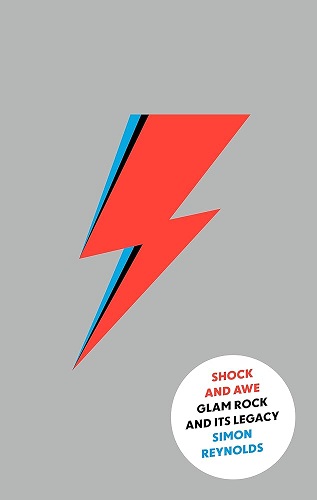
Shock and Awe: Glam Rock and Its Legacy
Simon Reynolds
687 pages including notes and index
published in 2016
Shock and Awe came out the same year David Bowie died, which seems fitting. Bowie after all being glam rock’s most enduring legacy. He had only been a one hit wonder with a couple of unsuccessful albums before he went glam. Ziggy Stardust was what made him famous. Playing a fictional rock star lead to becoming a real rock star, something of a theme in glam rock if Simon Reynolds is to believed. Fake till you make it, something Bowie’s biggest rival, Marc Bolan, also did. Glam rock as make believe, artificial, fake, camp and proud of it. Music for a new generation of pop fans, tired of their older brother’s “Beatles and the Stones” and looking for something more fashionable and cool than earnest long hairs in jeans doing interminable guitar solos. As its name implies, glam rock bought the glamour and excitement back to pop music, brought back a certain sophistication that was more rooted in European music traditions than American blues. An element of snobbery and intellectual disdain certainly was present too with Bowie and Bolan and especially with Bryan Fery’s Roxy Music.
Yet the defining image of glam rock is probably something like this: ugly old blokes in outlandish costumes doing well choreographed danceable foot stompers. Mud, Sweet, Suzi Quatro, Gary Glitter, Slade, Alvin Stardust and Wizzard all fit that profile. Artists that had been around the block already, plugging away with little or no success, markedly older than their audience unlike the previous generation of rock stars, who realised that what Bolan and Bowie were doing they could do as well. The image was as important as the music and the music was often somewhat interchangeable, not helped by the fact that e.g. Mud and Sweet shared the same song writers. Intensely popular in the early seventies, it all looked incredibly naff afterwards as punk hit the UK.
Yet there was more to glam rock than this, as Reynolds attempts to show in Shock and Awe. The starting gun for the whole glam rock movement was T.Rex’s first appearance on Top of the Pops in February 1971 and Reynolds also starts his book there, with Marc Bolan, chronicling how he evolved from a fairly standard hippie rocker into the most glamorous pop star of the seventies. Bolan started it, but it’s his friend and rival Bowie who is the red thread holding Shock and Awe together, his evolution as an artist driving the evolution of glam rock in a certain sense. Every third or fourth chapter he pops up again with the next stage in his development, from Ziggy Stardust to the Thin White Duke and finally his Berlin period.
In between there are chapters on the other strands of glam rock. Not just the foot stompers like Mud and Sweet, but also Alice Cooper, the New York Dolls, Sparks, Queen, Roxy Music, Steve Harley and even The Sensational Alex Harvey Band are examined. There are also the David Bowie proteges: Iggy Pop, Lou Reed, Mott the Hoople, already established artists getting a glam makeover courtesy of Bowie and finding some success through it they lacked before. A diverse bunch of artists, who outside of the Mud-Sweet-Glitter axis have little in common musically, yet certain elements can be found in all of them.
The fashion and the image consciousness of all of them is the most obvious of course. Each rejected the long hair and jeans looks of the older bands, going for a more glamorous, more outre look. A certain androgyny was part and parcel of this. Makeup and glitter, feminised clothing, a bit of sexual ambiguity can be found in most of these bands, though actual gay or even bisexual artists were rare. A sense of nostalgia, or looking back at older forms of rock music was also there, getting away from the ‘heaviness’ rock had evolved in by the early seventies. Ironically, this while their main audience was the so-called third generation of rock fans, young teenagers who hadn’t been alive for that first wave of rock they reached back to. There is also a heavy influence of older European music forms in many of these artists, especially with Roxy Music and of course Bowie.
Reynolds follows the story of glam rock until the late seventies, ending with David Bowie’s Berlin triology of albums: Heroes, Low and Lodger, in the process tracing the influences glam had on punk. The last chapter is a collection of moments in pop music showcasing glam’s continuing influence on pop and rock. This is the least convincing or interesting part of the book to be honest. At some point glam just becomes another part of the whole rock tradition and I’m not sure you could call Lady Gaga ‘glam’ just because she also dressed up or whatever.
The real test of any music book is always if it makes you want to listen to what it is about and Shock and Awe certainyl managed that. I’ve been on a Bowie/T.Rex/Roxy Music/New York Dolls kick ever since I started it. A good, very readable look at a perhaps still underestimated part of rock history.
More Simon Reynolds: Rip it Up and Start Again on the post-punk revolution.
No Comments